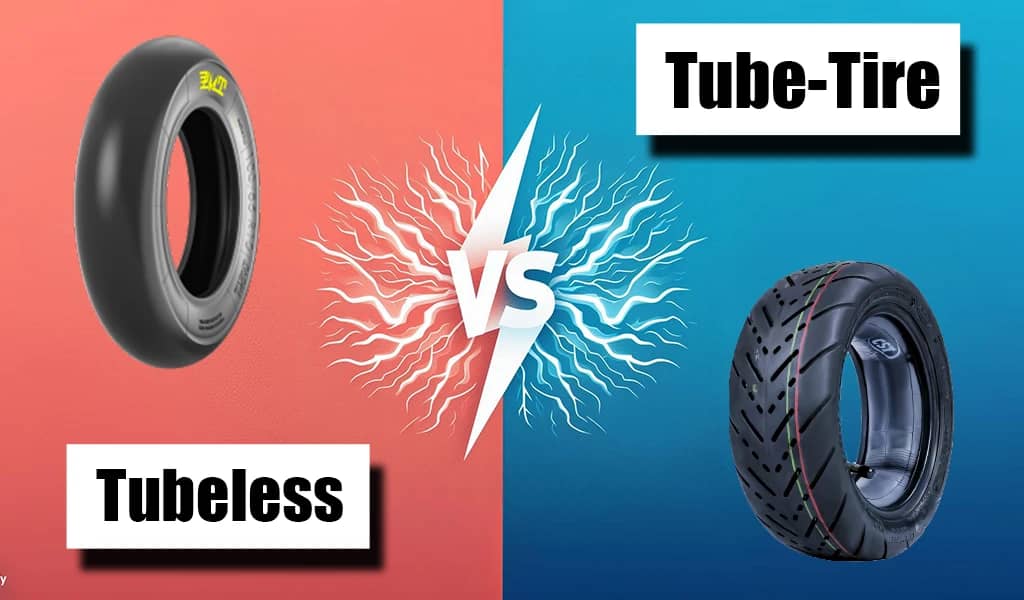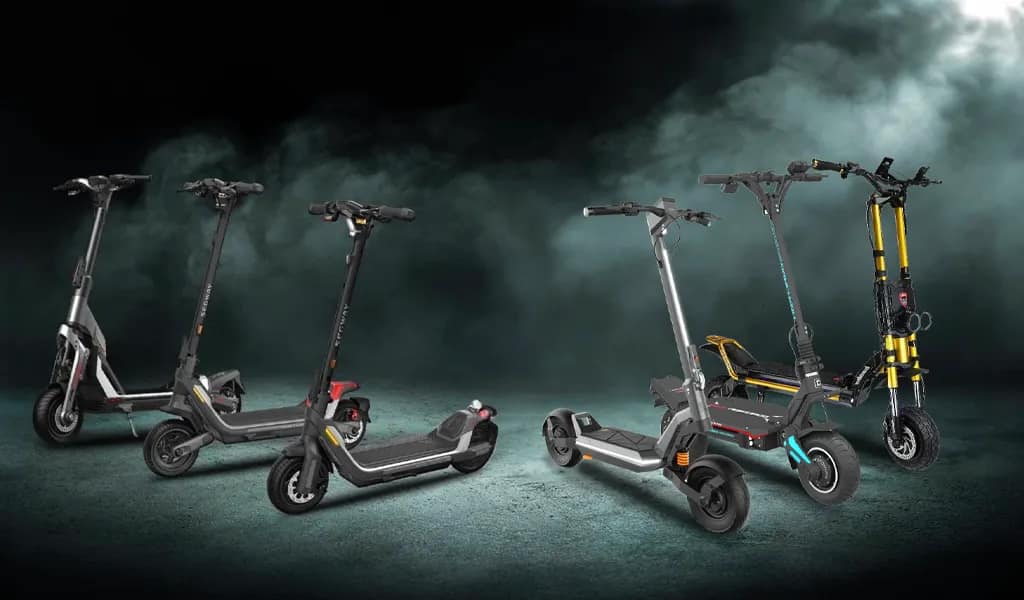
When it comes to electric scooters, every detail counts, and tire pressure is no exception. Having the accurate PSI (pounds per square inch) for your pneumatic scooter tires can make the difference between a smooth, enjoyable ride and a bumpy, inefficient one. The optimal PSI range for an electric scooter tire is between 38-48 psi based on our research data. But where you land in this range depends on your own preference and going lower or higher garners different benefits. You can optimize it for better handling, more cushioning, reduced puncture risk, and extended tire life.
In this guide, we’ll help you how to find the optimal tire pressure for your riding circumstances, backed by our own test data combined with the biggest manufacturers’ recommendations. We will also cover how various external factors like load, terrain, and tire type affect how much pressure you want to have.
Whether you’re a casual commuter or a performance rider, understanding tire pressure is key to maximizing performance and ensuring a safe, comfortable ride.
Basics of Electric Scooter Tire Pressure

Rule #1: Check Tire Pressure Regularly
I can’t stress this enough: you need to be on top of your tire pressure, especially if you’re riding an electric scooter with tubed tires. Letting your tires deflate too much increases the risk of getting a pinch puncture. Moreover, your scooter’s performance will suffer in terms of lower top speed, poor acceleration, reduced range per charge, and overall worse handling.
I recommend checking the tire pressure at least once a week. This practice helps you understand how much air loss you typically experience over a month and allows you to catch small punctures early by noticing unusual deflation. Early detection can save you from a future blowout, where you might need to replace the entire tire instead of simply repairing a puncture. Such incidents can cause significant harm to you as a rider.
Regular checks not only ensure your safety but also enhance your scooter’s performance and longevity.
Bar Versus PSI

In the world of air pressure, there are two main metric systems: bar and PSI. Here at ARideJunkie, we use PSI. However, as someone who grew up using the bar system, I won’t leave my fellow Europeans out to dry.
Most tire pressure gauges display both metrics, and nearly all tires have the recommended pressure marked on the sidewall. For simplicity, remember that 1 bar equals approximately 14.5 PSI. So, 42 PSI is approximately 2.9 bar (though technically, 1 bar is 14.5038 PSI, we round it for ease).
Finding The Perfect Tire Pressure
In all honesty there is no one magic psi number. Everyone will have their personal opinion on what will benefit their riding style the most. Some riders prioritize comfort and traction, while others want better range and speed. However, we’ve researched and found that the general recommended PSI for electric scooter tires by manufacturers is around 43psi.
Recommended PSI
After scourging the internet and combining data from 47 brands and over 250 electric scooter models, we got an average recommended PSI of 43.
With that as a standard measuring stock we found that depending on the rider’s weight the optimal PSI range for a pneumatic electric scooter tire is between 38-48. This strikes the best balance between performance, comfort, handling, and safety.
Tire pressure research data sample
| Brand | Model | Recommended PSI |
|---|---|---|
| Xiaomi | Mi Electric Scooter 4 PRO | 45 |
| Segway-Ninebot | MAX G30 | 36-42 |
| Razor | E300 | 36 |
| Kaabo | Wolf Warrior 11 | 50 |
| Dualtron | Thunder | 50-55 |
| Glion | Dolly | 36 |
| Hiboy | S2 Pro | 36-40 |
| Unagi | Model One (E500) | 32 |
| Apollo | Explore | 35-40 |
| Swagtron | Swagger 5 Elite | 28-35 |
| Gotrax | GXL V2 | 50 |
| Inokim | Light 2 | 40-45 |
| Turboant | X7 Pro | 35-40 |
| Varla | Eagle One | 40-45 |
| Inokim | Ox | 35-40 |
| Mercane | WideWheel Pro | 40-45 |
| Apollo | Phantom | 45-50 |
Temperature Effects on Tire Pressure
An oversight by many, but tire pressure can change depending on the weather. In colder temperatures, tire pressure will drop, while during warm periods it will increase.
What does this mean for the average rider?
This means that you need to implement more pressure checks during the extreme seasons. By checking your tires more frequently during this period of the year you will enjoy a better, more efficient ride no matter the weather.
Signs of Incorrect Tire Pressure
Incorrect tire pressure can show up in various ways:
Underinflated Tires: You’ll notice bulging sidewalls, sluggish acceleration, and increased rolling resistance.
Overinflated Tires: Expect a rougher ride, reduced traction, and a higher risk of blowouts.
How to Measure Tire Pressure

Measuring tire pressure is pretty straightforward:
- Remove the valve cap from your tire.
- Press the tire pressure gauge onto the valve stem.
- Read the gauge to see your tire’s current PSI.
- Adjust the pressure using an air pump or by releasing air as needed.
For the best accuracy, use a high-quality tire pressure gauge. Either you use your local gas stations, or you get your own digital gauge. They are often more precise and easier to read, definitely a great tool to have in your scooter maintenance arsenal!
Personalize Your Ride by Adjusting Tire Pressure
Depending on the terrain, type of tires, and rider weight you may want to adjust the psi up and down slightly depending on your preference.
As a general rule you want to add 1 psi per 22lbs(10kg) of rider weight starting from 132lbs(60kg) as that is the industry standard rider weight that most brands test their electric scooters with.
Do note that tubeless tires can be adjusted lower than tube-type tires, as innertubes are prone to pinch punctures. That is when the innertube will get punctured between the tire rubber and the rim. That is just one of many differences between tubed and tubeless electric scooter tires.
Performance of Higher vs. Lower PSI
Higher PSI:
Lower PSI:
Common Myths and Misconceptions
Starting out lets bust some myths and common misunderstandings of how tire pressure influences your electric scooter ride. Some riders think overinflating their tires will boost speed. While it might give a slight speed and range increase, it significantly reduces safety and comfort. So don’t over-do it
Overinflating can worsen both handling and grip, and it increases blowout risk, while underinflation can damage the wheel rim and create unnecessary strain on the motor and battery, while also increasing the risk of a puncture.
Conclusion
Understanding and maintaining the correct tire pressure is essential for maximizing the performance and safety of your electric scooter. Properly inflated tires ensure a smoother, more efficient ride, prolong the life of your scooter, and provide a safer riding experience. Whether you prioritize comfort, speed, or range, finding the right PSI tailored to your weight and riding conditions can make all the difference.
Remember, checking your tire pressure regularly is crucial. Make it a habit to inspect your tires at least once a month, and adjust the pressure as needed based on your riding conditions and preferences. By doing so, you’ll enjoy a more responsive, comfortable ride and avoid potential issues like punctures and reduced battery efficiency.
Thank you for reading our guide on electric scooter tire pressure. We hope this information helps you get the most out of your scooter, ensuring every ride is smooth, safe, and enjoyable—not just for you, but also for everyone else out there on the streets with you.







